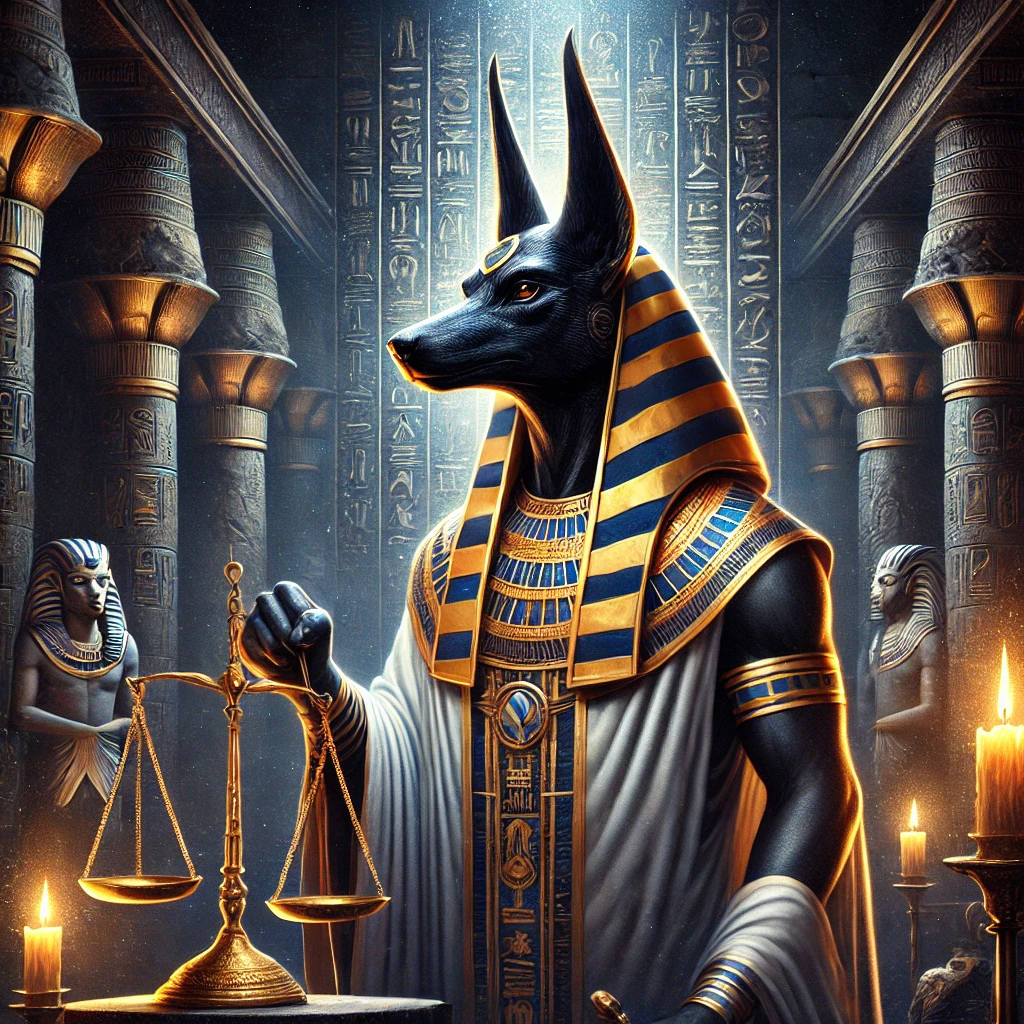Definition
Anubis is the ancient Egyptian god associated with death, mummification, and the protection of the dead. Often depicted as a man with the head of a black jackal, Anubis serves as the guardian of tombs, the guide of souls, and a protector of sacred rites in the afterlife. He plays a central role in ensuring the safe passage of souls through the Duat (Egyptian underworld) and is intimately linked with funerary practices and spiritual judgment.
Origins and Evolution
Anubis, known in ancient Egyptian as Inpu (or Anpu), is one of the oldest deities in Egyptian mythology, with origins tracing back to the Early Dynastic Period (c. 3100–2686 BCE).
- Originally considered the primary god of the dead, Anubis’s role shifted as Osiris rose in prominence during the Middle Kingdom.
- He then became the protector and embalmer of Osiris, assisting in his resurrection and overseeing the rituals that ensured the dead could enter the afterlife.
- Anubis remained an essential figure in funerary rites, tomb protection, and the judgment of souls.
Symbols and Iconography
- Black Jackal or Dog-Headed Man – The black color symbolizes both the fertile soil of the Nile (rebirth) and the color of mummified flesh (death). The jackal form is likely connected to wild dogs that roamed near cemeteries.
- Ankh – Symbol of eternal life, often held by Anubis.
- Flail or Staff – Represents power and guardianship.
- Scales of Judgment – Used in the Weighing of the Heart ceremony.
- Embalming Tools – As the patron of mummification, Anubis is often depicted overseeing the preparation of the body.
Roles and Powers
1. Protector of Tombs and Cemeteries
Anubis guarded graves from desecration, wild animals, and evil spirits. He was invoked in funerary inscriptions and amulets to safeguard the dead on their journey.
2. God of Mummification and Embalming
Anubis was believed to have invented the art of mummification when he embalmed the body of Osiris. Priests performing the ritual often wore Anubis masks, symbolically invoking his guidance during burial preparations.
3. Guide of Souls (Psychopomp)
Anubis led the deceased through the underworld toward the Hall of Ma’at, where their hearts would be judged. He was seen as a benevolent escort, helping the soul navigate the dangers of the afterlife.
4. Overseer of the Weighing of the Heart
In the Hall of Two Truths, Anubis performed the critical task of weighing the heart of the deceased against the feather of Ma’at (truth and balance).
- If the heart was lighter, the soul was pure and could proceed to the eternal afterlife.
- If the heart was heavier, it was devoured by Ammit, the soul-eater, and the person would cease to exist.
Temples and Worship
Unlike gods with major cult centers, Anubis was primarily venerated through tombs, shrines, and funerary practices rather than grand temples.
- Cynopolis (“City of the Dog”) in Upper Egypt was a primary cult center.
- Statues and paintings of Anubis were common in tombs and necropolises.
- Priests of Anubis played a vital role in burial ceremonies and were highly respected in Egyptian society.
Anubis’s worship was practical and mystical, rooted in the belief in life after death and the careful rituals needed to secure it.
Anubis in Mythology
Anubis and Osiris
According to myth, after Osiris was murdered and dismembered by Set, Anubis helped Isis reassemble and embalm Osiris’s body. Through this sacred act, Osiris became the god of the afterlife, and Anubis was honored as the patron of embalming and guardian of the dead.
Anubis in Later Cultures
- Greek and Roman Influence: The Greeks identified Anubis with Hermes, the messenger and guide of souls, creating a composite deity known as Hermanubis.
- Modern Symbolism: Today, Anubis remains a popular figure in esoteric, metaphysical, and pop culture circles, often representing protection, transition, and spiritual transformation.
Spiritual Significance and Modern Interpretation
In modern metaphysical contexts, Anubis is viewed as:
- A psychopomp who assists with soul retrieval, spiritual transition, and shadow work.
- A guardian of sacred boundaries between life and death.
- A symbol of personal transformation, protection during change, and deep inner guidance.
Anubis may be invoked during rituals for grief healing, ancestral connection, dreamwork, and spiritual protection.
Conclusion
Anubis is one of the most revered and recognizable deities of ancient Egypt, embodying the sacred transition between life and death. As a guardian, guide, and protector, Anubis ensures that the soul’s journey is safe, honorable, and just. His enduring presence in mythology and spiritual practice reflects humanity’s timeless quest to understand death, honor the dead, and find light within the mystery of the afterlife.

